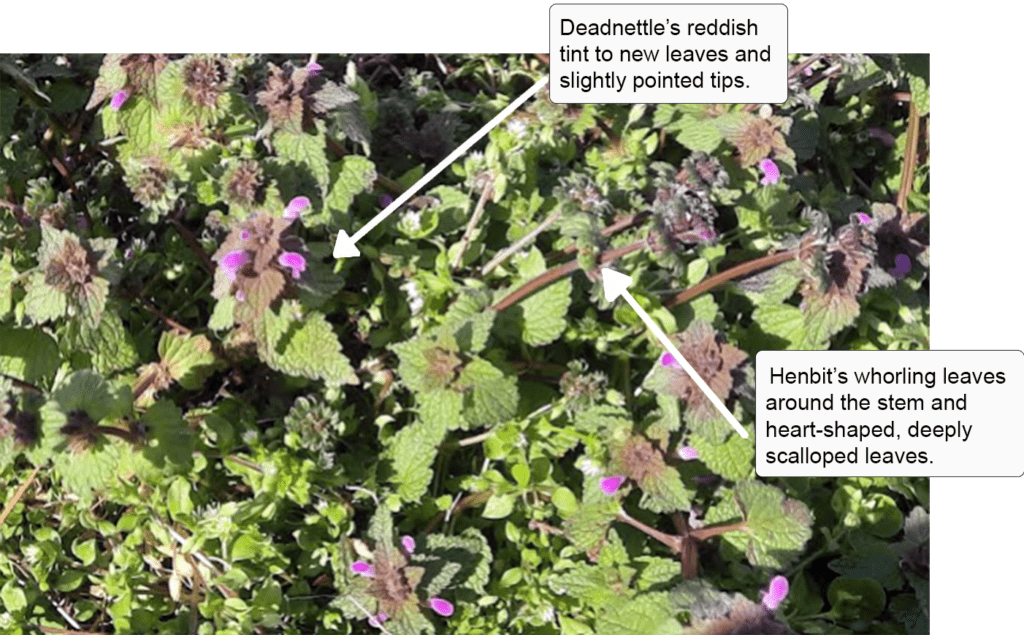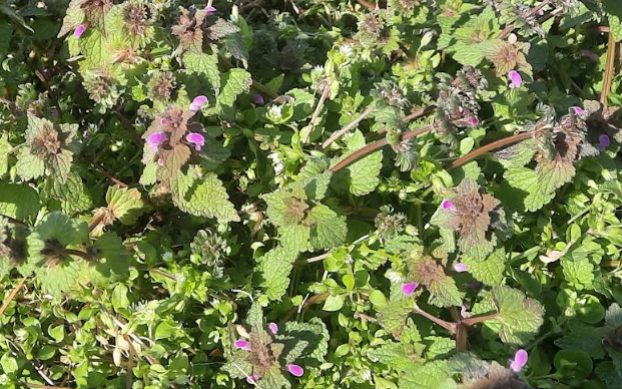As I walked my dog on a blustery mid-winter day, I noticed a field covered in purple haze. Looking closer, I discovered that the blooming wildflower (some might call a “weed”) was either henbit or purple dead nettle. Always confused by the difference between the two, I did a little investigation and concluded that what I was viewing was purple dead nettle. However, not too far away and a little behind in its bloom I saw henbit growing. So how do you tell the difference, and do they add any value to wildlife?
Purple dead nettle (Lamium purpureum) and henbit (Lamium amplexicaule) are both in the mint family, are winter annuals that form flowers and seeds in early spring and grow happily alongside each other. They both have fuzzy leaves, square stems, a similar height, and produce early spring blooms in a shade of purple at the top of their stems. But, to the discerning eye, there are some distinct differences between these two plants.
The leaves of purple dead nettle are at the top (apex) of the stem with the newer ones producing a reddish/purple tint. Their leaves are attached with a short petiole (stalk) and are slightly pointed at the tip.
The leaves of henbit are attached directly (no petiole) in whorls around the stem which has a reddish tint. Their heart-shaped leaves with deeply scalloped edges are spaced apart along the stem of the plant.

You may wonder if these plants are native and offer any value to early pollinators. Although they are identified in the Virginia Atlas of Virginia Flora as “Introduced,” they are not listed in the Lady Bird Johnson Wildflower database. Wikipedia says they are native to Europe and Asia. Even though they are not native, they do offer some value to wildlife. According to the NC Extension Gardener plant database, henbit is “an important early-season source of nectar and pollen for honeybees,” other sources include a benefit to bumblebees also. I learned that the nectar of purple dead nettle is attractive to bumblebees, honey bees and solitary ground-nesting bees.
And, if you are really hungry, both plants are edible. Young henbit shoots, flowers, and leaves have a mild, slightly peppered flavor. The brave can use them in numerous recipes including homemade pesto, soups, salads and stir fry. Dead nettle, with a milder, slightly spinach-like taste, can also replace leafy greens in many recipes.
Jane McKinley, ESVMG EMG
Jane has been a Master Gardener since 2015 and is an active member of the local Eastern Shore of Virginia Master Gardener unit. As a Master Gardener trained in environmental horticulture through cooperative programming with Virginia Cooperative Extension, Jane supports the mission to provide community horticulture education programs, protect the environment and educate others.



thank you for the reminder to appreciate all the plants in our gardens.